#mexican artifacts
Photo

Earthenware female figurine, Chupicuaro culture (central Mexico) , 300 BC - 100 AD
The Walters Art Museum
27 notes
·
View notes
Text

Ancient Mayan Nose Ring Made of Human Bone Found in Mexican
More than a thousand years ago, a priest in Mexico donned a bone nose ornament and conducted a ceremony in honor of K’awiil, the Mayan god associated with maize and fertility.
At least that’s what experts believe happened after they discovered a nose ring made from human bone at the Archaeological Zone of Palenque in Chiapas, according to an Aug. 29 news release from Mexico’s National Institute of Anthropology and History. It’s the first find of its kind from the site.
Experts described the artifact as “una nariguera,” which translates to a nose ring in English. However, photos of the object show that it was more like an ornament that sat atop the wearer’s nose.
The 2.5-inch-long and 2-inch-wide adornment is made of a human tibia (leg) bone, archaeologists said. It was likely used by elites, specifically rulers and priests, in attempts to personify their god, K’awiil.
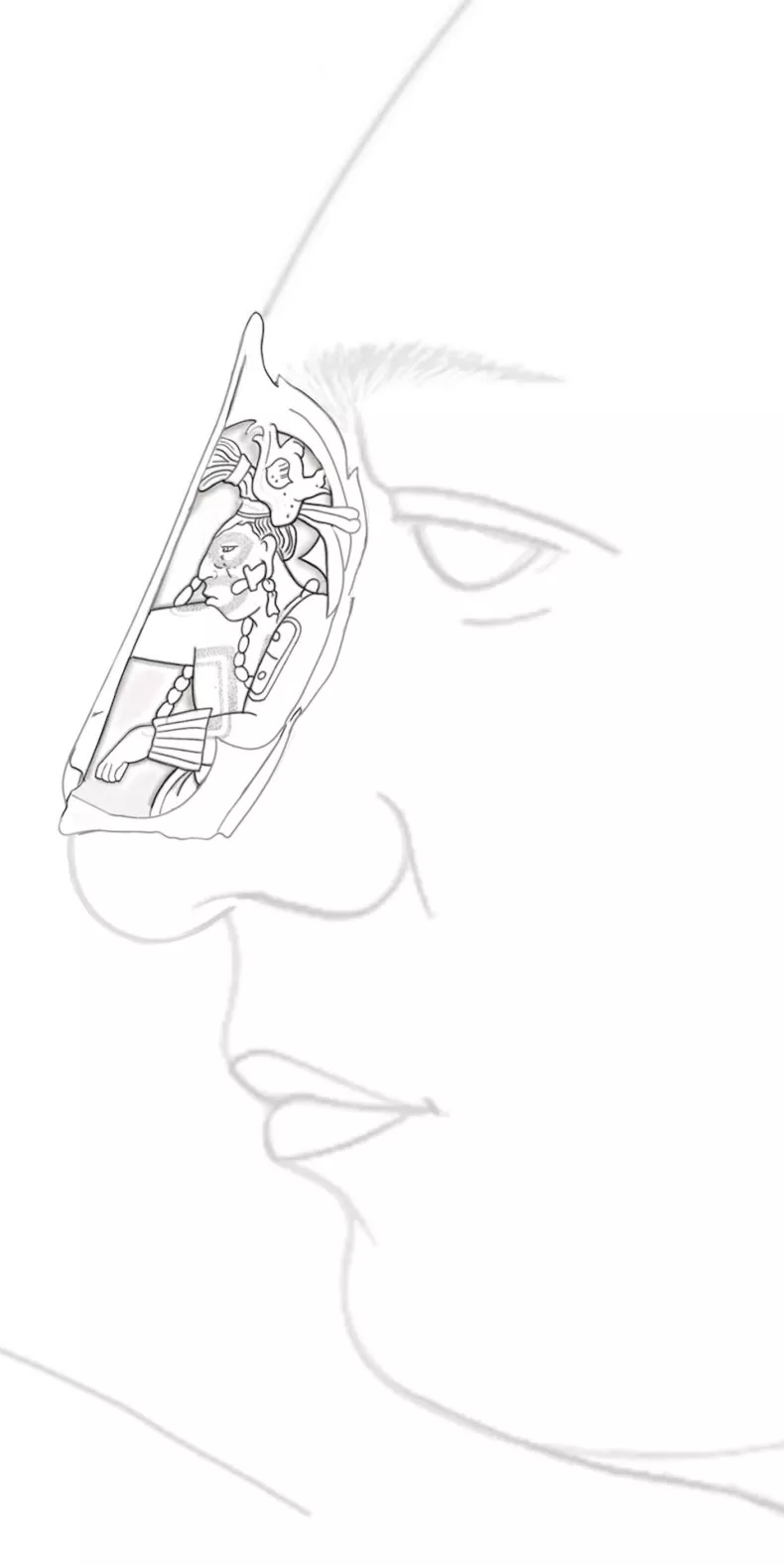
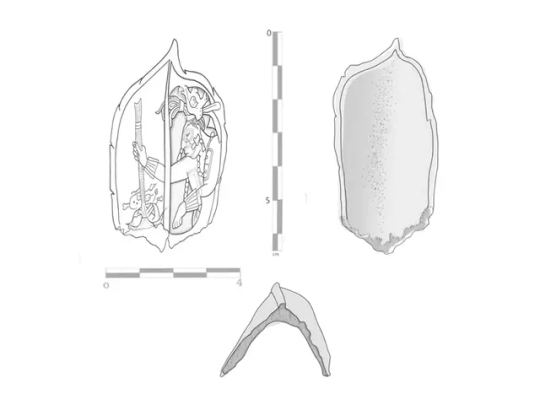
Experts said the bone artifact is engraved with a depiction of a man in a headdress and ornate jewelry. His left arm has the Mayan glyph “ak’ab’,” which means darkness or night. He is holding a long thin object, and beneath him is a human skull and long bones placed on a bundle of cloth.
The depiction in the bone expresses communication with gods and ancestors, according to experts.
The nose piece was unearthed from a ritual deposit buried between 600 and 850, archaeologists said. The deposit commemorated the building of a new structure, known as House C, at a palace.
Officials said they also found animal bones, obsidian blades and charcoal in the deposit.
Chiapas is in southeastern Mexico.
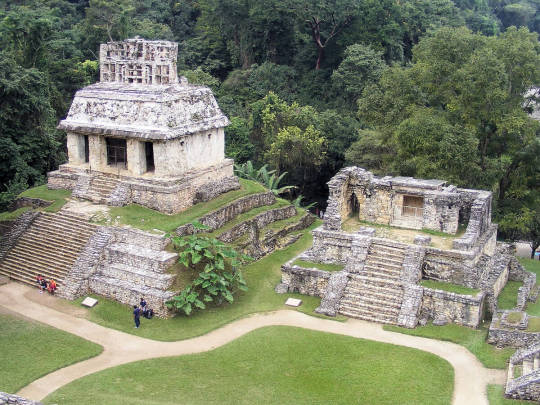


#Ancient Mayan Nose Ring Made of Human Bone Found in Mexican#Archaeological Zone of Palenque#ancient artifacts#archeology#archeolgst#history#history news#ancient history#ancient culture#ancient civilizations#mayan history#mayan mythology#mayan art
277 notes
·
View notes
Text
The Denver Post: A $12 million ancient Mexican artifact has been seized in Colorado. Now the “Earth Monster” is headed back home.
The Mexican delegation stood on the tarmac Friday afternoon near Denver International Airport, waiting under hazy skies for a forklift to deliver a wooden box, the contents of which archaeologists have been searching for nearly two decades.
Inside that box — 95 inches tall, 46 inches wide, emblazoned with the Mexican flag — sat a 2,000-pound, elaborately carved stone from the ancient Olmec civilization, a precursor to the Mayans who thrived more than 2,500 years ago near the Gulf of Mexico.
The prized relic, known as Monument 9 or the Earth Monster, was carefully crafted between 800 and 400 B.C. out of volcanic rock, archaeologists believe. Its wide mouth represents the door to the underworld.
“This is one of the pieces we have been looking for for the longest time,” said Jorge Islas, Mexico’s consul general in New York.
Authorities believe the stone artifact was stolen in the late 1950s or early 1960s from the central Mexican state of Morelos. It was exhibited in New York’s famed Metropolitan Museum of Art in the 1970s, and sometime after made its way into the hands of an unnamed private collector or collectors in Colorado.
Now the stone artifact — with an estimated $12 million value — is headed back to its ancestral homeland after authorities seized it Friday, part of a long-term investigation by the Manhattan District Attorney’s Office into stolen Olmec antiquities.
“This is testimony our nation is recovering our great patrimony,” Marcelo Ebrard Casaubon, Mexico’s foreign secretary, said during a news conference.
“A decisive civilization”
Monument 9 isn’t just any old Mexican antiquity.
The Olmecs were the earliest known major Mesoamerican civilization, dominating the tropical lowland of the modern-day Mexican states of Veracruz and Tabasco south of Mexico City.
Architecture from the Olmecs is quite advanced, said Mario Córdova, an archaeologist who accompanied the Mexican delegation to Denver. That’s why it’s so valued and desired.
“It was a decisive civilization,” Casaubon said.
The Earth Monster sports iconography of jaguars, revered as the most dangerous animal in Central and South America, as well as sacred mountains and indigenous plants.
Archaeologists don’t know how much was taken from the Chalcatzingo Archaeological Zone, but the looting was significant, Córdova said. Mexican authorities believe sometime in the late 1950s or early 1960s, looters broke Monument 9 into pieces and smuggled it into the United States.

The Met exhibited the work from July 1970 through February 1971 as part of its Before Cortes exhibition, a museum spokesperson said. The relic was on loan to the museum from the Munson-Williams-Proctor Arts Institute in Utica, NY.
Córdova and other archaeologists spent the past 18 years looking for this significant piece of Mexican history. It’s not clear when, or how, the multimillion-dollar antiquity made its way into the hands of the Colorado collectors.
Authorities didn’t divulge these individuals’ identities on Friday.
“They got a settlement,” Islas told The Denver Post. “They’re super famous, super wealthy people.”
The Mexican government approached the Manhattan District Attorney’s Office with evidence that the artifact had been stolen and authorities located it this year, said Alejandro Celorio, principal legal advisor for Mexico’s foreign ministry.
Douglas Cohen, a spokesperson for the Manhattan DA’s office, said Friday’s seizure came as part of a long-term investigation into stolen Olmec antiquities. The office sports an antiquities trafficking unit that spearheads some of the country’s largest art-crime investigations. In recent months, the team returned stolen artifacts to Iraq, China and Yemen, among other countries.
Recovering lost heritage
The Mexican government in recent years has prioritized cultural property repatriation efforts, scouring the globe for artifacts it believes to have been looted.
President Andrés Manuel López Obrador even launched a campaign under the hashtag #MiPatrimonioNoSeVende (“My heritage is not for sale”).
In March, authorities in France, Italy and Germany returned 86 cultural objects to Mexico. The Netherlands in December, meanwhile, returned 223 objects to the Latin American nation.
The country’s efforts come as the global south has increasingly pressed for the return of its heritage after decades of plundering and colonial rule. Museums and private collectors have faced increasing pressure — and attention from law enforcement — over the provenance of antiquities.
Córdova could hardly contain his glee as he stood on the tarmac at the private aviation terminal next to Denver’s airport.
In minutes, the archeologist would accompany the enormous wooden box on a military plane, headed for Mexico. Monument 9 by next week will be displayed at the Palace of Cortés, the famous conquistador’s former residence in Cuernavaca.
“I didn’t believe this was possible,” Córdova said in Spanish through an interpreter. “I’m just so happy.”
#Earth Monster#Mexico#colorado#stolen legacy#stolen treasures#cortes#cuernavaca#museums#A $12 million ancient Mexican artifact has been seized in Colorado. Now the “Earth Monster” is headed back home
1 note
·
View note
Text
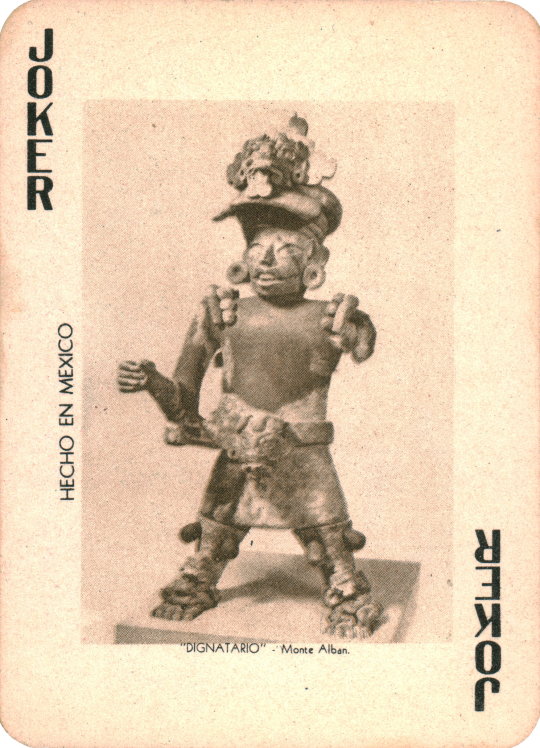
Hecho en Mexico
8 notes
·
View notes
Text

My comment which was too little, too late to the conversation.
When I was studying abroad for a semester at the Universidad de las Americas Puebla located near Cholula, Puebla, Mexico I took a cultural anthropology course. The professor told us one day that he had heard from locals in Puebla that they stole the rain from the neighboring state of Tlaxcala. He made some initial questions, got nowhere, and let the topic rest. A few years later while he was in Tlaxcala, he heard people complaining that Puebla was stealing their rain. That perked his ears up so he investigated the topic again. Eventually, he met a curandero who explained to him that in the spring he and some others would go to the mountain chain that separates Puebla and Tlaxcala and burn all the vegetation that was growing. This created a blackened surface which absorbed the sun's heat and released it at night displacing the cooler, wetter mountain air towards Puebla. This professor asked to be taken to the mountains and while walking around noticed broken pottery. Even though he was a cultural anthropologist, he recognized that the multitude of artifacts on the slopes were pre-Columbian and that people had been "stealing" rain for centuries.
So, yeah, I would say the Aztecs and other Central Mexican groups are smarter than Walsh.
Shoutout to Timothy Knab, the cultural anthropology professor at UDLAP. He's got some really entertaining books like "A War of Witches" and "Mad Jesus"
680 notes
·
View notes
Text
Hello and welcome to the US Southwest/Mexican Northwest Pottery Bracket!
Or, the "Greater Southwest," if you're writing from a USAmerican perspective, which I am.

The Greater Southwest was and is a vibrant, multicultural place, with a long history of settlement, movement, interaction, art, philosophy, and cultural exchange. And it's the home of some of the most striking and beautiful pottery in the world. No, I'm not biased.
The Greater Southwest has great, workable, colorful clays, and a hot dry environment that makes artifacts preserve well over the centuries. So there are a LOT of examples of pottery, from its initial use in this region 3000-some years ago to the modern art form made today.
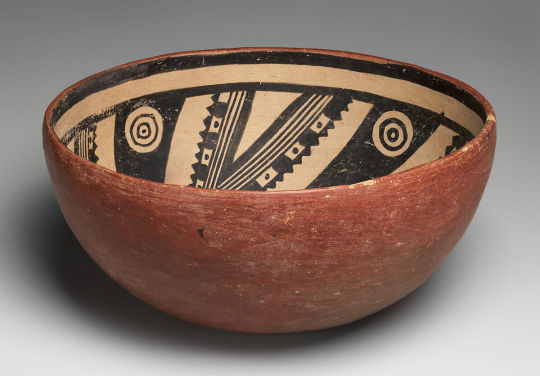
A Gila Polychrome bowl, southeastern Arizona, 1300-1450.
I'm @specialagentartemis and I'm an archaeology PhD student studying Southwestern pottery. This is my excuse to ramble about my topic of study and interest, and share a little bit about it with the world. And make it fun. I'll present the pottery... and YOU vote on it! Based on how pretty it is, or how interesting, or if it was made by your tribe, or whatever other criteria you like. This isn't voting on the objective best pottery, just tumblr's favorite.
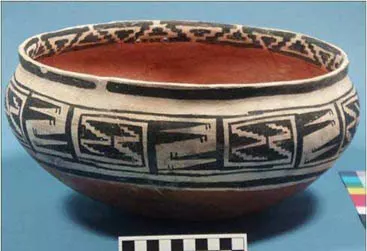
A Nine Mile Polychrome bowl, southeastern Arizona, 1375-1450.
In the spreadsheet I'm working with for my research assistanceship doing ceramic data analysis, there are 1,352 different pottery types listed. That is So Many. I will not be having you vote on every single one. I've pulled out 18 wares and types that I think exemplify Southwestern ceramic history across various times, places, styles, and cultures, from the AD 800s to the present day.
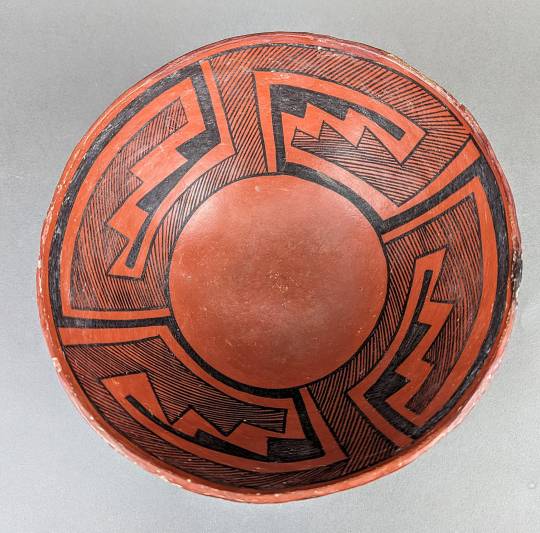
A Wingate Black-on-red bowl, western New Mexico, 1030-1175.
If you have questions, comments, propaganda for your favorite pottery, or a nomination for a pottery type to include, feel free to drop an ask!
I will not knowingly post any photos of pottery from burials.
(and, as traditional, I'll tag some fellow bracket pollsters who may be interested: @goldenapplebracket @gayest-classiclit @namedafterflowerstournament)
113 notes
·
View notes
Text

I guess I wanted to experiment some more until I find the right design for Daisy's Mum? so here's some random quick sketches and what-ifs. Excuse my messy handwriting haha. Part 1, cause I have more!
• I reckon that face wise, Daisy shares a lot more resemblance to her mother. I took inspiration for this from the 1993 Super Mario Bros movie, as Daisy’s mother is literally played by the same actress in the flashback. But with much darker hair.
• But in terms with the flair and colouring, Daisy’s traits from her father shines much more!
• Usually I did want for the Queen to have Middle Eastern/Persian inspiration. But i kind of given her the name Laelia, because it is a flower of Mexican origin. I know it’s too much of a reach. But sort of like Sarasaland’s Portuguese/Spanish influence?
• I’m thinking so far that Laelia is from a Kingdom that prides itself in artifacts? Knowledge? Gems? Honestly not sure yet! But I know that she really adores nature and studies subjects relating to nature.
• As a Princess, she wears mostly Mauves and blues, to symbolize a blue orchid. And possibly the colours or her kingdom. After she marries into the Royal Sarasaland Family, she starts to wear more brighter and warm colours, showing how she truly loves and embraces the land’s culture.
• The King, Richard (since the fans seem to have given him this name, so I’ll refer to him as that!) Absolutely adores the Queen. From their first meeting, he was already quite smitten with her! But she wasn’t focused on love at first, and was studying at the time. Every simply glance she gives him. Every time she politely calls his name. It reduces the tough and stern King into a flustered mess.
It was even more prominent even before they were crowned! He tried to impress her on some occasions haha.
He’ll be afraid of silly things. But if it’s right in front of her, he’ll puff up his chest and brave it out…most of the time!
Is it cheesy for him to say that her eyes shine like the most beautiful of gemstones? Well, according to his Royal friends they might!
• It’s also why that if the Queen was ‘whisked away forever’, Richard becomes absolutely devastated. Heartbroken. The Queen brought warmth into his life, and it was taken away from him. But knowing that he still has his Daughter, is enough to keep him going.
But! I wonder if there’s a possibility of her returning somehow?
#fanart#digital art#artists on tumblr#art#super mario#nintendo#the super mario bros movie#princess daisy#sketches#sarasaland#super mario land
142 notes
·
View notes
Text

After you read this 👇 take a good löök at the photos below...
///>>>Welcome to the Matrix<<<\\\
1 > There is NO SPACE in the way we are taught to think about it;>
2 > We live in a completely enclosed ecosystem under a dome, called the Firmament;>
3 > No one can come visit from another “planet”, because they can’t break through the dome;>
4 > For the same reason no one can fly to another “planet”;>
5 > When they talk about space and planets, they mean deep ocean and other continents accessible only via the deep ocean;>
6 > Antarctica is not a continent - it’s a giant containment ice-wall, surrounding a crater called “earth”; it’s also called the “van allen belt”;>
7 > One can leave the earth crater only deep under the ocean through gates on the bottom of the ocean and reach other continents, called “planets”;>
8 > The seven planets of our solar system are allegories and are not physical places/realms;>
9 > We reside on this giant continuous terrain/realm called the “universe”;>
10 > There are many other continents, called “planets”, outside the Antarctica wall;>
11 > There are many living beings living on these continents outside the earth crater, called “aliens”;>
12 > These “aliens” are previous creations and some of them look humanoid;>
13 > There are humans being enslaved on the other continents outside of the earth crater - what they call “space colonies”, hence why over 8 Million humans disappear every year;>
14 > The original Nephilim bloodlines are alive and well living underground the “earth” crater and on the other continents outside Antarctica belt;>
15 > The “earth” is not as old as we are told - it’s way younger than we are told;>
16 > We are currently in year 723 +/- a few years A.D. and not in year 2023;>
17 > 1300 years of invented human history never happened - they were simply added to obscure the destruction of Tartaria and explain architecture and remaining artifacts; Tartarian super-advanced technology was deliberately destroyed although it is unclear who destroyed it and who the parasites were;>
18 > Tartaria did exist although I believe its location is different than what we are told and also its original name is most likely different too; its descendants have survived and live outside of the “earth” crater; one thing I have been unable to confirm is whether the Tartarians are descendants/bloodlines of the Nephilim, although I do believe that is most likely the case;>
19 > Most of the aliens are manufactured synthetic robotoids;>
20 > There was a mass manufacture of human [most likely cloned] babies, therefore the sudden explosion of orphans with unknown origins in the late 1800s and early 1900s - it’s possible these were the original soulless NPC bloodlines that represent more than half of all humans today;>
21 > The “earth” is a non-rotating stationary flat realm/crater within a much larger continuous terrain/plane/realm called the “universe”;>
22 > Souled humans are being farmed as animals; the words “male” and “female” actually depict the sex of an animal, not human; in the late 1770s and early 1800s humans were only described by the words “man”, “woman”, “boy” and “girl”, and then suddenly for unknown reasons [or more likely under unknown influence], humans began to be described as female and male, which was the way only animals were described at the time;>
23 > There is more than one great flood, the question is who and what caused the more recent ones;>
24 > The Egyptian civilization is not the oldest one; the Bosnian pyramids are twice as large as the Egyptian ones and have been hidden from the world for the longest time;>
25 > In fact there are pyramids all over Europe, quite a few of them older and bigger than the Egyptian ones; even the Mexican pyramids are older than the Egyptian ones - there has been a concerted effort to hide a vast amount of history from us;>
26 > I come from a tribe that is 2500 years old, one of the oldest in Europe; I have the feeling that we will discover that a significant part of the Egyptian and Babylonian history is fabricated.>
///>>> The Matrix <<<\\\
If you have not researched anything about the earth, I suggest you do. NASA and the powers that be have lied to everyone about who we are and where we live. This is one of the BIGGEST lies to ever be forced on the people.
STOP 🛑 be-LIE-ving in their fabricated stories. 🤔
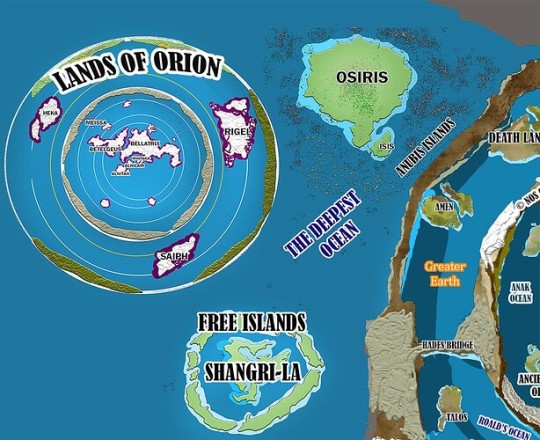

Beyond the ice wall is the "Outer Space" 👇
Let this sink in. 🤔
#pay attention#educate yourselves#educate yourself#knowledge is power#reeducate yourself#reeducate yourselves#think for yourselves#think about it#think for yourself#do your homework#do some research#do your own research#do your research#question everything#ask yourself questions#flat earth#earth
138 notes
·
View notes
Text
Anthropologist Zelia Nuttall transformed the way we think of ancient Mesoamerica
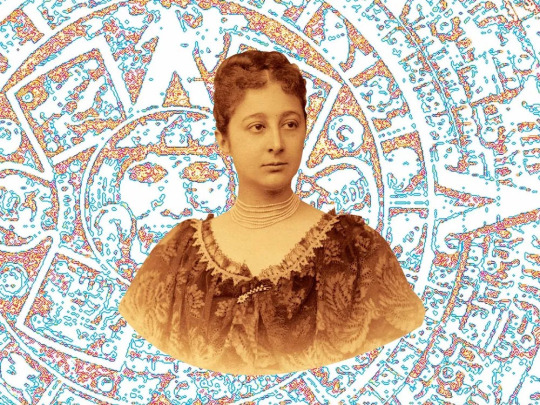
An illustration of the Aztec calendar stone surrounds a young portrait of anthropologist Zelia Nuttall. “Mrs. Nuttall’s investigations of the Mexican calendar appear to furnish for the first time a satisfactory key,” wrote one leading scholar.Peabody Museum of Archaeology and Ethnology, Harvard University
By Merilee Grindle
Author, In the Shadow of Quetzalcoatl: Zelia Nuttall and the Search for Mexico’s Ancient Civilizations
On a bright day early in 1885, Zelia Nuttall was strolling around the ancient ruins of Teotihuacán, the enormous ceremonial site north of Mexico City. Not yet 30, Zelia had a deep interest in the history of Mexico, and now, with her marriage in ruins and her future uncertain, she was on a trip with her mother, Magdalena; her brother George; and her 3-year-old daughter, Nadine, to distract her from her worries.
The site, which covered eight square miles, had once been home to the predecessors of the Aztecs. It included about 2,000 dwellings along with temples, plazas and pyramids where they charted the stars and made offerings to the sun and moon. As Zelia admired the impressive buildings, some shrouded in dirt and vegetation, she reached down and collected a few pieces of pottery from the dusty soil. They were plentiful and easy to find with a few brushes of her hand.
The moment she picked up those artifacts would prove to be pivotal in the life and long career of this trailblazing anthropologist. Over the next 50 years, Zelia’s careful study of artifacts would challenge the way people thought of Mesoamerican history. She was the first to decode the Aztec calendar and identify the purposes of ancient adornments and weapons. She untangled the organization of commercial networks and transcribed ancient songs. She found clues about the ancient Americas all over the world: Once, deep in the stacks of the British Museum, she found an Indigenous pictorial history that predated the Spanish conquest; skilled at interpreting Aztec drawings and symbols, and having taught herself Nahuatl, the language of the Aztecs and their predecessors, she was the first to transcribe and translate this and other ancient manuscripts.
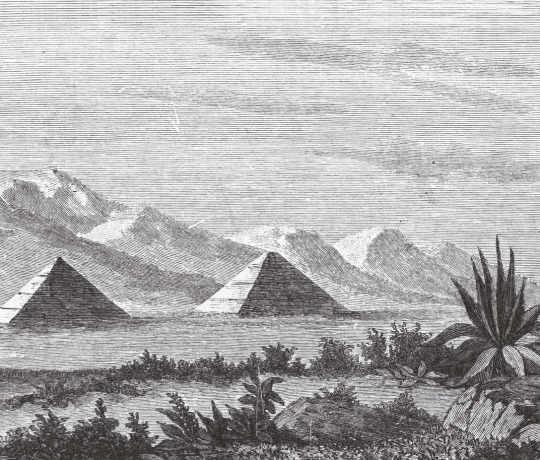
A 19th-century engraving of the pyramids of Teotihuacan. The Pyramid of the Sun was restored in 1910, on the centennial of the Mexican War of Independence. Bridgeman Images
She also served as a bridge between the United States and Mexico, living in both countries and working with leading national institutions in each. At a time when many scholars spun elaborate and unfounded theories based on 19th-century views of race, Zelia looked at the evidence and made concrete connections based on scientific observations. By the time she died, in 1933, she had published three books and more than 75 articles.
Yet during her lifetime, she was sometimes called an antiquarian, a folklorist or a “lady scientist.” When she died, scholarly journals and some newspapers ran notices and obituaries. After that, she largely passed from the public’s eye.
Today, anthropologists often have specialized expertise. But in the 19th century, anthropology was not yet a discipline with its own paradigms, methods and boundaries. Most of its practitioners were self-taught or served as apprentices to a handful of recognized experts. Many such “amateurs” made important contributions to the field. And many of them were women.
She was born in 1857 to a wealthy family in San Francisco, then a fast-growing city of about 50,000 people. Near the shore, ships mired in mud—many abandoned by crews eager to make their fortunes in the gold fields—served as hostels to a restless, sometimes violent and mostly male population. Other adventurers found uncertain homes in hastily built hotels and rooming houses. But the city was also an exciting international settlement. Ships arrived daily from across the Pacific, Panama and the east via Cape Horn.
Her well-appointed household stood apart from the city’s wilder quarters, but the people who lived there reflected San Francisco’s international character. Her mother, Magdalena Parrott Nuttall, herself the daughter of an American businessman and a Mexican woman, spoke Spanish, and her grandfather, who lived nearby, employed a French lady’s maid; a nursemaid from New York; a chambermaid, laundress, housekeeper, coachman and groom from Ireland; a steward from Switzerland; a cook and additional servants from France; and nine day laborers from China.
When Zelia was 8, her family left San Francisco for Europe. Along with her older brother, Juanito, and her younger siblings Carmelita and George, Zelia and her parents set off for Ireland, her father’s native land. Over the course of 11 years, the Nuttalls made their way to London, Paris, the South of France, Germany, Italy and Switzerland. Throughout that time, Zelia was educated largely by governesses and tutors, with some formal schooling in Dresden and London. But her time overseas shaped her interest in ancient history and expanded her language skills, as she added French, German and Italian to her fluent Spanish. All of this expansion thrilled her mind, but it also made her feel increasingly out of step with the expectations for young women of her age. “My ideas and opinions form themselves I don’t know how, and I sometimes am astonished at the determined ideas I have!” she wrote in a November 1875 letter.
She took refuge in singing and tried to be pleased with the few social events she attended. Photos from the time show Zelia as an attractive young woman with large, dark eyes, arched eyebrows and stylishly arranged hair. Nevertheless, she was unhappy. “I was infinitely disgusted with some of the idiotic specimens of mankind I danced with,” she wrote in an 1876 letter after a party.
The Nuttalls returned to San Francisco in 1876, when she was nearly 20. Two years later, she met a young French anthropologist, Alphonse Pinart, already celebrated in his mid-20s as an explorer and linguist. He had been to Alaska, Arizona, Canada, Maine, Russia and the South Sea Islands. Pinart may have led the family to understand that he was wealthy. In fact, he was almost penniless, having already spent his significant inheritance.
They were married at the Nuttall home on May 10, 1880. During the next year and a half, the couple traveled to Paris, Madrid, Barcelona, Puerto Rico, Cuba, the Dominican Republic and Mexico. Pinart introduced Zelia to a burgeoning academic literature in ethnology and archaeology, and she began to understand the theories of linguistics. She found 16th-century Spanish hardly a challenge as she consulted annotated codices—pictorial documents that traced pre-Columbian genealogies and conquests in Mesoamerica. While Pinart dashed from project to project and roamed widely among countries, tribes and languages, Zelia began to demonstrate an intellectual style that was more focused and precise.
Despite the excitement of discovery, something began to go wrong in the marriage. Hints of Zelia’s distress can be found in her effusive letters home. There was, for example, the shipboard admission that her husband was less attentive than she had anticipated. She noted that he was “so quiet and undemonstrative” that it was hard to imagine they were newly married. Some fellow passengers thought they were brother and sister—an odd assumption to make, even in Victorian times, about newlyweds.
By contrast, Zelia is nowhere to be found in Pinart’s surviving correspondence. On April 6, 1881, she gave birth to a daughter, Roberta, who lived only 11 days. To add to this melancholy time, her beloved father died in May, leaving her doubly devastated. A letter Pinart wrote to a friend just a few months later from Cuba appeared on stationery with a black border, signifying mourning, but he made no reference to his wife, her father or their child.
Zelia found solace in learning about her heritage when she and Pinart traveled to Mexico in 1881. She was eager to see her mother’s homeland and to hone her understanding of its pre-Columbian cultures. While Pinart carried out his own research, she began to learn Nahuatl, and she toured villages where dialects of the language were still spoken and ruins where the marks of the past could still be found.
The couple returned to San Francisco on December 6, 1881. By then, Zelia was pregnant again. In late January, Pinart set out to spend several months in Guatemala, Nicaragua and Panama, while Zelia awaited the birth of her second child, Nadine, at her mother’s house.
What finally drove Zelia to sue for divorce, on the grounds of cruelty and neglect, remains elusive. She may have felt that Pinart had married her for access to her family’s fortune. Many years later, she angrily informed Nadine that Pinart had spent the $9,000 she had inherited from her father as well as her marriage settlement. When the money was gone, and when her family was firm that he shouldn’t expect any more, he abandoned his wife and child. Once Zelia demanded a separation, he did not contest it, though obtaining the divorce was a long process that started soon after the couple’s return from their travels and didn’t conclude until 1888.
In later life, Nadine Nuttall Pinart would reflect on how much it had cost her to grow up without a father. “From the time before I can remember, he was taboo to me,” she wrote in a 1961 letter to Ross Parmenter, a New York Times editor who wrote numerous books about Mexico and developed a fascination with Zelia Nuttall. “I was frightened by the violent scoldings I got for mentioning his name. Later, I compromised with myself and when asked about him quietly said, ‘I never knew him!’ I realized that people thought he was dead and were sorry for me and said no more. In those days it was a disgrace to have a divorced mother.”
If the period between 1881 and 1888, when Zelia finalized her divorce, was fraught with tension and heartache, this was also when she set about redefining herself as a woman with a vocation. She spent five months in Mexico with her mother, her daughter and her brother between December 1884 and April 1885, visiting Cuernavaca, Mexico City and Toluca, and exploring archaeological ruins. It was during this time that Zelia made her fateful winter visit to Teotihuacan and acquired her first artifacts.
The pieces of pottery she picked up that day were small terra-cotta heads. They were abundant in the area among the pyramids. At the time, the site was still being used as farmland, and the artifacts came to the surface during ploughing. The heads themselves were an inch or two long, with flat backs and a neck attached. Scholars before Zelia—Americans, Europeans and Mexicans—had mused creatively about such relics, describing differences in their facial features and the variety of headdresses they had sported. Drawing on 19th-century fascination with the topic of race, the French archaeologist Désiré Charnay became convinced that he could see in them African, Chinese and Greek facial features. Charnay mused: Had their creators migrated from Africa, Asia or Europe? And if racial identity was a marker of human development, as many believed at the time, what might this curious mixture of features reveal about civilizations in the Americas?
This kind of thinking was typical. Mistaken ideas about Darwinism led many Western scholars to believe that civilizations evolved along a linear, hierarchical path, from primitive villages to ancient kingdoms to modern industrial and urban societies. Not surprisingly, they used this to legitimize beliefs about the superiority of the white race.
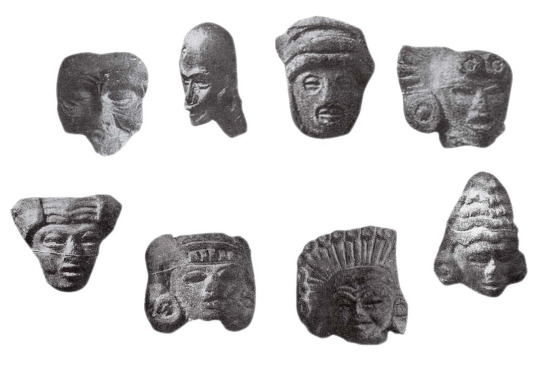
Zelia Nuttall divided her collection of terra-cotta heads into three classes. The first included rudimentary efforts to represent a human face (as seen above, far left). The second class (including the bald second head from the left above) had holes for attaching earrings and other ornaments. The third category included the rest of the heads pictured here, sporting what Zelia called “a confusing variety of peculiar and not ungraceful headdresses.” Public Domain
Zelia generally accepted her era’s assumptions about race and class, and she was comfortable with her elite status and its privileges. Yet in her research, she did not categorize civilizations as primitive, savage or barbaric, as other scholars did, nor did she indulge in racial theories of cultural development. Instead, she sought to sweep aside this kind of speculation and replace it with observation and reason.
The more Zelia examined her terra-cotta heads, the more she realized she needed guidance from someone who had more experience in the study of antiquity than she had. At the time, there were no departments of anthropology in colleges or universities, no degrees to be earned, no clear routes to building a career. To pursue her burgeoning interest in the ancient civilizations of Mexico, and to decipher the meaning of an assortment of terra-cotta heads, she contacted Frederic Ward Putnam, the curator of Harvard’s Peabody Museum of Archaeology & Ethnology and a leading expert on Mesoamerica. He agreed to meet her in the fall of 1885. The meeting was all she hoped for: Putnam warmed to her work and encouraged her to follow her intuitive grasp of how to observe and interpret evidence.
Putnam’s regard for women’s intellectual capacities was clear. He was one of a small number of Harvard researchers who gave lectures at “the Annex,” an institution established for women who had passed the college’s admissions test but were not allowed to attend classes or earn a degree. (The Harvard Annex eventually became Radcliffe College.) He hired a resourceful administrative staff of women and encouraged them to play a role in managing the museum. He also had a “correspondence school,” which he conducted through a widespread exchange of letters. As he once wrote, “Several of my best students are women, who have become widely known by their thorough and important works and publications; and this I consider as high an honor as could be accorded to me.”
Within months of their first encounter, in late 1885, Putnam asked Zelia to become a special assistant in Mexican archaeology for the Peabody. Less than a year later, in the annual report of the Peabody Museum, he wrote about her appointment in glowing terms: “Familiar with the Nahuatl language … and with an exceptional talent for linguistics and archaeology, as well as being thoroughly informed in all the early native and Spanish writings relating to Mexico and its people, Mrs. Nuttall enters the study with a preparation as remarkable as it is exceptional.”
With guidance from Putnam, Zelia wrote an investigation of the terra-cotta heads, her first published scientific report, which appeared in the spring 1886 issue of the American Journal of Archaeology. “At the first glance,” she wrote, “the multitude and variety of these heads are confusing; but after prolonged observation, they seem to naturally distribute themselves into three large and well-defined Classes.”
Each class, she theorized, had been created at a different time and represented a different stage in the culture. The first class contained “primary and crude attempts at the representation of a human face.” The second class included the first efforts at artistry. Her inspection revealed “holes, notches and lines,” suggesting ways in which tiny headdresses, feathers or beads could have been attached to the heads, and noted traces of several colors of paint and different kinds of clay.
The third class was the most important, Zelia argued, because of the quality of the molding and carving. This class had “modifications of feature sufficient to give every specimen an individuality of its own,” she wrote. “The faces are invariably in repose, in some the eyes are closed … faces young and smooth, others very elongated, some with sunken cheeks, others with wrinkles.”
By comparing these terra-cotta heads with ancient pictographs and writings, she showed that some of the heads represented children while others depicted young men, warriors or elders. Others showed the distinct hairstyles described in the writings of Bernardino de Sahagún, a 16th-century Franciscan friar who spent 50 years studying the Aztec culture, language and history. “The noblewomen used to wear their hair hanging to the waist, or to the shoulders only. Others wore it long over the temples and ears only,” Sahagún had written. “Others entwined their hair with black cotton-thread and wore these twists about the head, forming two little horns above the forehead. Others have longer hair and cut its ends equally, as an embellishment, so that, when it is twisted and tied up, it looked as though it were all of the same length; and other women have their whole heads shorn or clipped.”
These concrete observations allowed Zelia to challenge popular ideas about the supposed African, Asian, European or Egyptian origins of the “races” in the Americas. For example, by studying the ornamentation the heads displayed, she was able to identify the person or god each artifact represented and interpret its ritual or symbolic purpose. One clearly corresponded with Tlaloc, the pan-Mesoamerican god of rain, who had been shown in the pictographs with a curved band above the mouth and circles around the eyes. Another head, molded with a turban-like cap, corresponded with the goddess Centeotl; Zelia speculated that the clay turbans once had real feathers attached. She also noted the significance of various poses. “In the picture-writings, closed eyes invariably convey the idea of death,” she wrote.
The article revealed how Zelia intended to be seen as a scholar. First, she made it clear that she had read what others had written. Then she revealed that she would go beyond existing speculation to answer questions that had puzzled others; hers was to be original and important work.
In 1892, Zelia presented a paper in Spain about the Aztec calendar stone. Buried during the destruction of the Aztec Empire, the calendar stone had been unearthed in December 1790, when repairs were being made to the Zócalo, Mexico City’s central plaza. The sculpted stone, some 12 feet in diameter and weighing 25 tons, became a popular attraction exhibited in the Mexico City Cathedral, steps from where it had been found. Antonio de León y Gama, a Mexican astronomer, mathematician and archaeologist, had written about its discovery and praised the intelligence of the Aztecs who had created it. Alexander von Humboldt, who saw the stone when he visited Mexico in 1803-1804, included a drawing in his Views of the Cordilleras and Monuments of the Indigenous Peoples of the Americas, published in 1810, and encouraged Mexican intellectuals to study the meaning of its concentric circles and numerous glyphs. Many others took on its puzzles in the years that followed.
At the time of Zelia’s presentation, the Mexican upper classes were carefully crafting a new national image—a story that would allow Mexico to take its place among the modern nations of the world. The Aztecs, Maya, Olmecs, Toltecs, Zapotecs and other cultures had left their imprints throughout the country in magnificent temples, enigmatic statues, gold jewelry, jade figurines and painted murals. This history was reclaimed as a national heritage every bit as glorious as those of Greece and Rome. A statue of Cuauhtémoc, the Aztec king who resisted Cortés, took its place on Mexico City’s elegant Paseo de la Reforma in 1887. The calendar stone had been installed in a place of honor in the National Museum in 1885. But little was known about the actual customs and beliefs of those ancient people.

The Aztec calendar stone, a central focus of Zelia’s research, has been on display at Mexico City’s National Museum of Anthropology since 1885. Alamy
With her extraordinary knowledge of surviving codices, Zelia offered a novel “reading” of the giant calendar stone that had stumped others and provided new insights into the annual and seasonal cycles of daily life in ancient Mexico, illuminating the cosmology, agriculture and trade patterns of the Aztecs. She presented another version of the paper at the World’s Columbian Exposition in Chicago in 1893.
Zelia returned to Mexico City in February 1902, and after a personal audience with Mexican President José de la Cruz Porfirio Díaz, arranged by the U.S. ambassador, she embarked on a spree of travel to archaeological sites she had long wanted to visit. In May, she and 20-year-old Nadine joined friends at the Oaxacan ruins at Mitla, a religious center, where the “place of the dead” harbored both Mixtec and Zapotec art and architecture. On this dry, high plain ringed by mountains, Zelia strolled across vast stone patios, inspected the elaborate geometric friezes that lined and decorated them, explored temples and imagined a sophisticated society of kings, priests, nobles, artisans and farmers.
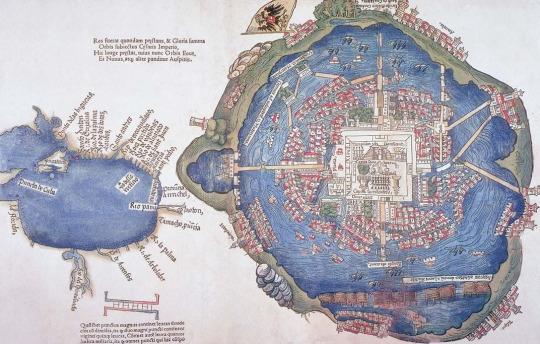
When the Spaniards arrived in Mexico in the 16th century, the Aztec Empire dominated the area. This map of its largest city, Tenochtitlan (now the historic center of Mexico City), was printed in 1524 in Nuremberg, Germany, likely based on a drawing by one of Hernán Cortés’ men. It shows the city’s elaborate network of roads, bridges and canals, complete with aqueducts and bathhouses. The Spaniards executed the last Aztec ruler, Moctezuma II Xocoyotzin, and forced his people to convert to Catholicism. Alamy
Zelia was welcomed into the international community of anthropologists in Mexico. She and Nadine traveled in the Yucatán with the young American anthropologist Alfred Tozzer, where they were beset by frequent rain and terrible roads. Arriving tired and wet in a small town, Tozzer, who would one day chair Harvard’s department of anthropology, was impressed by the women’s resilience. “Imagine the picture,” he wrote to his family on April 8, 1902. “Mrs. Nuttall, never accustomed to roughing it, a woman entertained by the crowned heads of Europe, sitting at a bench with the top part of my pajamas on drinking chocolate and her daughter with a flannel shirt of mine on doing the same.”
After a few months, Zelia and her daughter returned to Mexico City and purchased a mansion they called Casa Alvarado, in the upscale suburb of Coyoacán. The grand house never failed to impress. Frederick Starr, an anthropologist from the University of Chicago, was one of many who found the palace beautiful and restful: “We rode out to Coyoacán where we found Mrs. Nuttall and her daughter really charmingly situated. The color decoration is simple and strong. Nasturtiums are handsomely used in the patio and balcony effects. … While Mrs. Nuttall dressed, Miss Nuttall showed us through the garden, where a real transformation has been effected.”
Living in Mexico energized Zelia. In addition to her affiliation with Harvard, she had funding to travel and collect artifacts for the Department of Anthropology at the University of California. “With me here, in touch with the government and people, I think that American institutions can but profit and that I can do some good in advancing Science in this country,” she confided to Putnam.
Impressed by her knowledge of the country’s past, public officials and foreign visitors came to see her and listened carefully as she led them around her home and garden, explaining the collection she was busy assembling. Her garden, patio and verandas were home to an increasingly large number of stone artifacts, a beautiful carving of the serpent god Quetzalcóatl, revered for his wisdom, among them. She took up “digging” near Casa Alvarado, an activity one guest later recalled fondly. “Every morning after breakfast Mrs. Nuttall would give me a trowel and a bucket. She herself was equipped with a sort of short-handled spade, and we would go out into the surrounding country and ‘dig.’ We mostly found broken pieces of pottery, but she seemed to think some of them were significant, if not valuable. … She was a very handsome woman and very charming. She lived in great style, with many Mexican servants.”

The Codex Borgia, an accordion-folded document of Aztec life, was brought to Europe during the Spanish colonial period. Made of animal skins and stretching 36 feet when unfolded, the codex catalogs different units of time and the deities associated with them. It also includes astrological predictions once used for arranging marriages. Zelia drew on the codex to help her decode the Aztec calendar. Courtesy Ziereis Facsimiles

A section from the Codex Borgia
Zelia continued to travel throughout the country. She found a 14-page codex painted on deerskin, with commentary in Nahuatl, that she believed so valuable that she bought it with her own money, selling some of her possessions to afford it. “Owing to my residence here I must keep it a profound secret that I possess and sent out of the country this Codex,” she wrote to Putnam.
While she was not above smuggling treasures out of Mexico, Zelia also worked in the National Museum, contributing to its displays and archives, and she became an honorary professor of the institution.

Zelia had never owned a home until she bought Casa Alvarado in 1902. In a letter, she described the property as “a beautiful old place with extensive gardens.” Smithsonian Archives
Her Sunday teas at Casa Alvarado were a study in salon orchestration. “She would have 30 or 40 people and she would change the groups she invited,” one visitor recalled. “Sometimes they were all people who knew each other. Or else she would bring people together she wanted to introduce to each other. They weren’t like old-style Mexican parties, with all the women on one side and men on the other. The men and women were mixed together.”
According to an oft-repeated legend, at one of her soirées, she advanced to welcome an eminent guest just as her voluminous Victorian drawers came loose and dropped to her ankles. She calmly stepped out of them and proceeded as if nothing had happened. Zelia was, above all, self-confident.
Zelia Nuttall left Mexico during the early months of 1910 and did not return to her beloved Casa Alvarado for seven years. Throughout that time, Mexico was in the midst of a violent revolution. As many as two million people lost their lives in the ten-year conflict, and the country’s infrastructure was reduced to tatters. Even after the end of the most extensive violence, turmoil erupted sporadically until the late 1920s.
By then, visitors to Casa Alvarado agreed that Zelia was rooted in a bygone era. She was a middle-aged woman with thick glasses who favored shawls, laces and jet beads. Her palace was still filled with stuff only a Victorian could accumulate, but Mexico was telling new stories about itself.

The writer D.H. Lawrence used Zelia as a model for a fictional character—“an elderly woman, rather like a Conquistador herself in her black silk dress and her little black shoulder-shawl.” Antropo Wiki
The elites of the previous generation had asserted that descendants of the Aztec, Maya and other civilizations deteriorated into poverty and abandon. Young artists and intellectuals now rejected this belief. In Diego Rivera’s vast public murals, he showed the people of Mexico being ground into poverty and submission by Spanish conquistadors, a rapacious church, foreign capitalism, the army and cruel politicians. Quetzalcóatl replaced Santa Claus at the National Stadium; Chapultepec Park hosted Mexico Night.
Zelia did not like the revolution and she did not approve of what came after it. She did not celebrate the masses; she believed in hierarchy and a natural order of classes and races. Yet she was determined to be relevant to a new era in Mexico. Casa Alvarado became a meeting place for politicians, journalists, writers and social scientists from Mexico and abroad, many of whom came to witness the possibilities of change in the aftermath of a people’s revolution.
Nevertheless, the stubborn elegance of Casa Alvarado in the 1920s was clear testimony that Zelia was not willing to give up her lifestyle. When the French American painter Jean Charlot was a guest at one of Zelia’s teas, he was aghast at the Mexican servants in white gloves.
When Zelia Nuttall died in 1933, the U.S. consul in Mexico City wrote to Nadine—by then a 51-year-old widow living in Cambridge, England—assuring her that they’d given her mother a tasteful funeral. “Your Mother was very highly thought of here, as evidenced by the floral offerings and the number of her friends who came to the funeral service at the cemetery, it being estimated that about one hundred persons were present.”
By that time, the field of anthropology was dramatically changing, becoming more systematic and organized. Those who entered the field in the 1920s and 1930s built expertise in the classroom and under supervision in the field, passing a variety of tests and milestones determined by academic experts and acquiring a credential as proof of the right to pursue these inquiries. With these rigorous new standards, they asserted their superiority as scholars over those of Zelia’s generation.

Researchers thought this item at Vienna’s Museum of Ethnology was a “Moorish hat” before Zelia identified it as a Mesoamerican headdress. Alamy
Yet Alfred Tozzer, in his memorial in the journal American Anthropologist, reflected that Zelia “was a remarkable example of 19th-century versatility.” She was wrong in some of her overarching theories. For instance, she fallaciously argued that ancient Phoenician travelers had carried their culture to Mesoamerica. But she was right about many other things. Through her letters, articles and books, we can trace what she got right and what she got wrong as a scholar, and we can follow her as she moved from one research obsession to the next.
Her private life is harder to grasp. Among all the artifacts, there is little about the quips and gossip she exchanged with friends, the piano music she liked to play and sing. We cannot know what was in the boxes of papers in the cellar of Casa Alvarado that were burned in the housecleaning undertaken by its new tenants. We cannot retrieve personal and public documents lost in the San Francisco earthquake in 1906.
What we do know is that she had to make sacrifices, often very personal ones. We can feel her vulnerability, uncertainty, anger and embarrassment in the letters she wrote, as well as her self-assuredness. It required unusual self-discipline to learn so many languages and to gain a mastery of ancient pictographs. Her almost constant travels imperiled her health even while they advanced her vast network of friends, colleagues and patrons. But she continued to work, and that work helped establish the foundation on which many others now build.
A single mother pursuing a career while looking after a family in a man’s world: In some ways, Zelia Nuttall was a very modern woman.
Adapted from In the Shadow of Quetzalcoatl: Zelia Nuttall and the Search for Mexico’s Ancient Civilizations by Merilee Grindle, published by The Belknap Press of Harvard University Press. Copyright © 2023 by Merilee Grindle. Used by permission. All rights reserved.
#Women in history#Women in Anthropology#Zelia Nuttall#The Aztecs#Merilee Grindle#In the Shadow of Quetzalcoatl: Zelia Nuttall and the Search for Mexico's Ancient Civilizations#Books by women#Books about women#teotihuacan#mesoamerica#Nahuatl#Published women#Many of the first anthropologists were women#Alphonse Pinart was just another man who blew through his money#Women's careers flourishing after dumping a parasitic man#Frederic Ward Putnam#Men who encouraged women#The Annex#Lady scientist
40 notes
·
View notes
Text









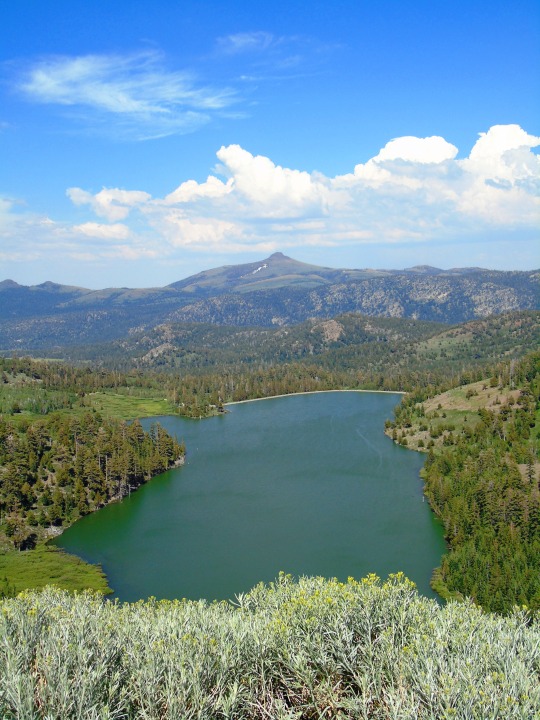
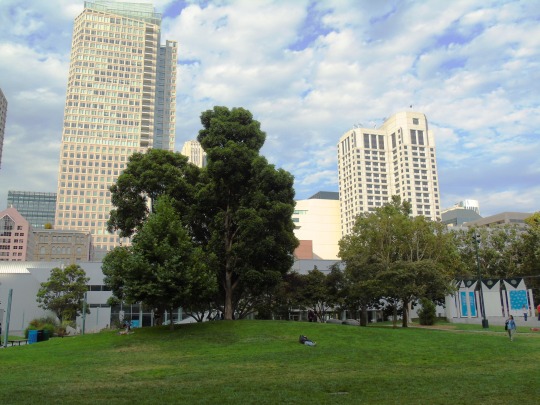












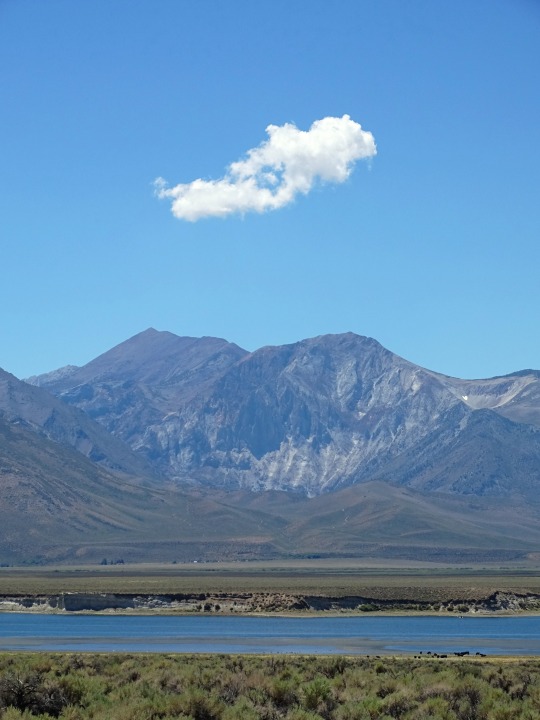
California was admitted as the thirty-first U.S. state on September 9, 1850.
California Admission Day
California Admission Day is observed on September 9 each year. It commemorates the day California was admitted into the Union as the 31st state in 1850 after it was ceded to the United States by Mexico in 1848. California became one of the few states to become a state without first being an organized territory. California Admission Day is not a federal holiday. Rather, it’s a local observance in the state, which implies that businesses, schools, and government offices remain open. In times gone by it was celebrated with great pomp and ceremony with parades and pageantry. Though low-key now, the day still marks an important part of Californian history.
History of California Admission Day
The Mexican-American War began in May 1846 when the U.S. declared war on Mexico. American settlers who lived in the territory of California in Mexico revolted against the Mexican government in what is known as the Bear Flag Revolt. The Americans captured Sonoma, hoisted a Bear Flag in the area, and declared it the California Republic. On July 9, 1846, Navy Lieutenant Joseph Warren Revere arrived in Sonoma and replaced the Bear Flag in the territory with a United States flag. Lieutenant Revere officially declared California a possession of the United States. In February 1848, Mexico and the U.S. signed the Treaty of Guadalupe Hidalgo to end the war. This treaty meant that Mexico had to yield a large portion of its Southwest territory — including present-day California — to the U.S.
As of the signing of the treaty, California had a meager population that was not up to the 60,000-inhabitant benchmark a territory needed to achieve statehood. Earlier in January 1848, gold was discovered on the American River near Sacramento, and the territory witnessed a massive influx of immigrants looking for work and good fortune. Thanks to the Gold Rush, a huge increase in population and wealth followed, thus necessitating the need for civil government and local policies.
In 1849, Californians demanded statehood, and California became the 31st state on September 9, 1850. California joined the Union as a free, non-slavery state by the Compromise of 1850 in just about two years of the territory’s incorporation. Its first capital was in San Jose before it was moved to the city of Vallejo for lack of necessary facilities. The capital was later moved to Benicia, a small town, and subsequently to the riverside port of Sacramento in 1854.
California Admission Day timeline
1846
The Bear Flag Revolt
American settlers in California stage a revolt against Mexican authorities.
1848
A Treaty for Peace
The United States and Mexico sign the Treaty of Guadalupe Hidalgo to end the war between the countries.
1850
The Compromise of 1850
The Compromise of 1850 is signed and California is admitted as the 31st state to the Union.
1911
Adoption of the California State Flag
The California State Flag, based on the original Bear Flag, is adopted by the state legislature.
California Admission Day FAQs
Is California Admission Day a federal holiday?
California Admission Day is not a federal holiday. It’s a local observance in the state of California. Schools, businesses, and government offices remain open.
What are other names for California?
California is also known as ‘The Golden State, ‘The Land of Milk and Honey,’ ‘The El Dorado State,’ and ‘The Grape State.’
What is California famous for?
California remains one of the most popular destinations throughout North America. The state is especially famous for Hollywood, Disneyland, and the Golden Gate Bridge. Other unique landmarks in California include Coachella, Silicon Valley, the Wine Country, and Surf Culture.
California Admission Day Activities
Visit the Golden StateIf you’re a history buff, today’s the perfect day to visit California. Museums around California offer various resources and artifacts to help you learn more about the state’s rich history. Take a day trip or make a holiday of it and travel to more than one.
Enjoy the special eventsCalifornia Admission Day is observed with special events at schools, museums, and organizations throughout the state. Public officials often grant special addresses about its history and significance.
Take a trip to SonomaCalifornia Admission Day has been observed particularly in the Sonoma area since 1850. It would be nice to visit the area where it all began. Don’t forget to enjoy the state’s beautiful beaches, valleys, and mountains as you celebrate with them!
5 Fun Facts About California
Originally named “the Grizzly Bear State": California has renamed the Golden State from its initial name “the Grizzly Bear State” as the bears went extinct.
The state motto is ‘Eureka!’: The Greek word means “I have found it!” and alludes to the discovery of gold in the Sierra Nevada.
Redwood is the official state tree: California’s official state tree is the redwood, as designated in 1937.
It’s called ‘The Grape State’, too: Over 300,000 tons of grapes are grown in California annually, and the state produces more than 17 million gallons of wine each year!
Blue jeans: In 1873 blue jeans were imported for miners from Europe, making San Francisco the first place in the U.S. where jeans were worn.
Why We Love California Admission Day
Becoming a recognized state in the U.S.This event celebrates the day California officially became a state in the U.S. It was a protracted struggle but thanks to the peace treaty that ended the Mexican-American War of 1848, it was a done deal.
A tribute to the war heroesThe struggle to acquire California as a possession of the U.S. was not an easy one. It took a war, diplomacy, protests, and legislation to make it possible. This day celebrates the memories of everyone who fought to make it possible.
The population boost that came with the Gold RushCalifornia’s low population would have hindered its prospects to become a state and admittance to the Union. Thanks to the Gold Rush, the territory was able to have the 60,000 inhabitants it needed to achieve statehood.
#Mount Shasta#California#31st US State#9 September 1850#Pacific Ocean#San Francisco#Sierra Nevada#Yosemite National Park#Morro Bay#Sonoma#Big Sur#San Diego#Humboldt Redwoods State Park#Los Angeles#Napa Valley#Death Valley National Park#travel#original photography#vacation#tourist attraction#landmark#architecture#cityscape#landscape#USA#Lake Tahoe#Santa Monica#Santa Barbara#anniversary#US history
24 notes
·
View notes
Photo

Anni Albers holding pre-Columbian miniature, 1935-1967. "Anni Albers and her husband and fellow artist, Josef Albers, met at the legendary Bauhaus in Weimar, Germany and became influential teachers there before emigrating to the United States, where they nurtured students at Black Mountain College and Yale University. Their ideas about modern art, however, were profoundly shaped by a different country. Between 1935 and 1967, they made no less than thirteen trips to Mexico and encountered art and artifacts that changed the way they thought about material, color, and abstraction." From "Pre-Columbian Mexican Miniatures: The Josef and Anni Albers Collection", 1970. https://www.instagram.com/p/CgxGqCUtX0J/?igshid=NGJjMDIxMWI=
383 notes
·
View notes
Photo

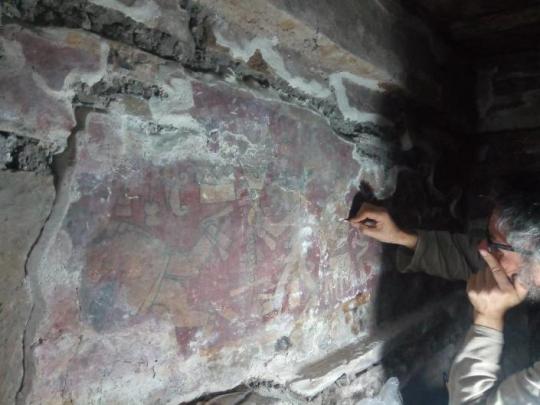
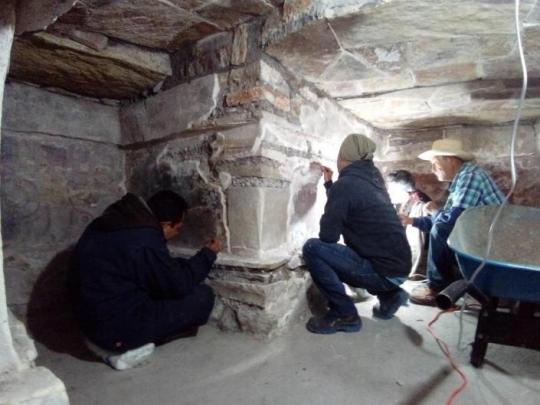


Colorful Murals Decorate 800-Year-Old Tombs Discovered in Mexico
Armed with weapons and shields, a group of warriors fight a fierce battle, their efforts preserved in red and black pigment — memorialized as a mural. Century after century, the warriors stood on the wall of a tomb complex in Mexico.
Archaeologists excavating a tomb complex in San Pedro Nexicho found themselves face-to-face with the faded fighting figures, Mexico’s National Institute of Anthropology and History said in a news release Wednesday, Jan. 18.
Excavations at the site uncovered five tombs dating from 200 A.D.to 1,200 A.D., researchers said. The burial sites belonged to the Zapotec people, an indigenous Mexican people group that formed one of the largest and most important pre-Hispanic settlements in the region.
The Zapotec — whose people and culture still thrive today — were the “first American society to develop a written tradition,” according to teaching materials from Haverford University.
Located on a mountain terrace, the largest tomb had a small ramp leading into the cross-shape burial structure, according to the release. Paintings decorated the walls, black-outlined figures moving across a deep red background.
A neighbor found this mural-covered tomb in 2010, and archaeologists spent years studying the site and restoring the structure to its former glory, officials said.
During this project, archaeologists uncovered four more Zapotec tombs, all over 800 years old. Some of these tombs had been looted, leaving only a few items behind such as small beads and fabric scraps, researchers said. Two tombs, however, remained untouched for centuries, their full burials intact.
In these untouched tombs, researchers found bones of the deceased and 240 objects, including writing tablets and sculptures in a unique mountain style. Photos show a few of these funerary objects.
In total, archaeologists have found about a dozen ancient Zapotec tombs, according to the release. These five tombs provide a glimpse into the burial customs for elites during pre-Hispanic times.
San Pedro Nexicho is in the state of Oaxaca and about 305 miles southeast of Mexico City.
By Aspen Pflughoeft.
#Colorful Murals Decorate 800-Year-Old Tombs Discovered in Mexico#San Pedro Nexicho#zapotec people#indigenous Mexican people#archeology#archeolgst#ancient tombs#ancient graves#ancient artifacts#history#history news#ancient history#ancient culture#ancient civilizations
77 notes
·
View notes
Note
One of the most uncomfortable things my brain has done has been getting attached to Mary. Like, Mary as in Mary the mother of Jesus. Not surprising but awkward for sure.
Mary is a big deal for mexicans. Regardless of anything, she is very important to our culture. Even the most brutal cartel or gang members will lower their heads and cross themselves in humility to the holy image of her. Taxi drivers hang rosaries (long bead artifacts with an amazing amount of technical specifications behind them that are meant to guide prayers towards Mary) on their mirrors to feel protection, and it's not badly viewed for people to wear rosaries as collars either. She's on the murals. She was our first ever flag. There's even one very very specific holiday we have for her, can't say I've ever celebrated it, but here in the small town where I live, people light fireworks everywhere and it's this big ass loud and happy celebration. Originally brought by colonizers to replace the goddess Tonantzin, the image of a brown skinned Mother Mary has become a symbol of and for our people. Hell, half of our fucking female population is called Maria Guadalupe (Lupe, for short) after her local name –Santa María Guadalupe. Don't even get me started on the advocations of the Virgin Mary, because theres like, A WHOLE ass different lore for that. Over here we have one called La Virgen del Pueblito (literally "The virgin from the small town").
Having said that, of course the jewish woman who accidentally recreated the fucking Pietá with the huge catholic dude with a saviour complex, as his side bled because he had a fucking nail stuck in there, WAS GOING to get attached to the jewish woman who is a LITERAL PART OF THE PIETÁ alongside THE VERY MAN MY EXBOYFRIEND WORSHIPPED and she birthed, as he also BLED FROM HIS SIDE, with NAILS stuck in his BUTCHERED HANDS.
Like, if you think about it, Mary also got ultra crucified for the sins of humanity inside of the christian lore. I do not believe this happened at all and I am not like, going to fucking convert to catholicism, but oh man. Oh man man man. Do I think of her often, with all these statues that mostly portray her in such a state of grief, looking up at the sky with hope on her big tender eyes full of tears, begging for mercy and forgiveness. Or with that compassionate soft gaze, meant to fall over the audience at the sanctuaries and parishes, filling all of their faithful spirits with motherly joy.
I do not have a mother, Feral. There's a warmth in that woman's eyes, some type of comprehension people often grow to find on their favourite characters or their favourite shows. I wouldn't say I believe in her as the holy mother of like, the almighty Christian Messiah or all that, but all I can think is "man, she's so me. Look at her, gifting herself to the christian Gxd, hoping her son will save the world as promised, knowing she will suffer but being so willing to do so for the sake of people that couldn't care any less".
I am and will always be jewish. As insufferable as it is, jews are my people and I wouldn't change that ever, it's my pride and joy to be a part of our tribe. But if I ever had to mutter a christian prayer, maybe I'd give one to her. Maybe I'd dedicate a rosary to my non religious, secular idea of her.
This is """problematic""" as fuck but this is what trauma does to a motherfucker. You cope the way you can and stick to it.
Any way to cope with being alive that doesn't cause physical injury is among the better ones, and being attached to something that's a huge part of the world you know isn't odd. You don't get to choose who your people are - in the sense of where you come from. But you do get to choose where you're going.
I've never met a catholic in real life. The christians here are lutherans, they don't believe in martyrdom or having sanctity or grace in suffering and sacrifice. In a way I sometimes wonder if they'd be more sympathetic to the suffering of others if they saw any value in it. Or even their own suffering. Languish, acceptance and embracing grief are more or less foreign concepts to them. They don't believe in saints, in Mary, or - no matter what they say - in a loving G-d.
Grief needs an outlet, some way for it to bleed out or it will fester. And not to sound messianic (fuck those clowns), but as much as we know of Jesus of Nazareth, he was still a jew, born of a jewish mother. All things considered, who else would you reasonably turn to?
9 notes
·
View notes
Text
ok so the other day on tumblr i mentioned that if one were to keep walker and his goons as characters than i'd rather have them be guys in white agents than essentially ghost cops imo
thru thinking abt this some more i think came up w an idea on how i want prisoners love/public enemies to look in my re:animated au along w how i can incorporate this excellent point my mutual made once

essentially the giw i.e. walker and his guys capture wulf after he crossed paths w danny on a patrol one night and rather than danny being the one who could've gotten caught it was wulf who took fall for this kid who he barely met
this sticks out to danny and figures that he now owes it to this guy to get him out
to me the heist happening later in mid/nearing the end of s1 is key bc this ep is the culmination of the trio over course of this season having to come together and work as a team essentially the potential heist is going to put that to the test
i'm also combining the prison break from prisoners of love here so that although initially danny only came here for wulf once he sees the other ghosts that are trapped there he feels obligated to free them as well and along w help wulf retrieve an artifact (the infini map) that he was ultimately trying to keep away from the giw
bc with that under their possession they could finally complete their objective which is to eradicate all ghosts in the ghost zone from the town
rather than the school and the mayor promoting the fentons as the ones who are tasked w dealing w the supposed threat of the ghosts at large it's the giw who are instead brought in
to me this change works on account them being a government funded organization so they have a certain level of public authority that maddie/jack don't
since they're not ghosts this time around and can't possess ppl in order to frame danny, they instead use the power and authority they do wield to enforce whatever narrative they want so that the denizens will believe that they have to trust and rely on them even if they don't actually have the town's best interest at heart and what they're doing is completely self serving
if that means making out wulf and soon afterwards danny as public threats so be it
even though we know danny isn't an actual threat to anyone but rather actually has the town's best interest at heart and is doing a much better job at performing his civic duty rather than ppl who supposedly claim that they do
and bc of the stunt him and sam/tucker pulled off he's now on the giw's shitlist specifically walker and his guys as they were put in charge of handling this case and failed horribly according to their superiors so now walker has personal grudge against danny bc of this
it's also worth noting that if you've been following me for awhile then yk that bc i read danny as a brown mexican kid, the fact his status as ghost is making him the target of a goverment funded organization specifically designed to detain him and others like him
the real world parallels i'm trying to draw here aren't exactly subtle and that's on purpose
also the fact that giw want the infini map which is a ghost artifact that belongs rightfully to the ghost zone and not them but is then stolen by them and claimed as a government property that they then intend to exploit as a tool in assisting their eradication of ghosts further adds to my au's overarching theme of colonialism btw
37 notes
·
View notes
Text
S2 E5-"Breakage
Sorry about the long posting gaps, new job+sick+RDR2+L+ratio etc. Favorite line from this episode is "why don't you stop being such a freak about everything" I think I should be paid to say that to Walt once an hour.
TW: Racism, police brutality, addiction, alcoholism

So I've always been really unsure what to make of the cold opening of the two illegal immigrants crossing the Rio Grande. With the analytic frameworks I've applied until this point I think I'm choosing to understand it as complicating the idea that violence is sneaking up into the US across the Mexican border. Two scared, shivering men cross the river, and on the other end find an artifact of state-sanctioned violence. It never had to be imported from "lawless Mexican hell", as Marie describes it. We grow it just fine right here.
The cigarettes Walt finds jammed in the toilet act in visual parallel to Jesse's meth that he tried to flush down the toilet last season. The scene where he confronts Skyler about them is chockful of hypocrisy. Smoking while pregnant is bad for the baby's health. So is being a meth dealer trading with people who will shoot your whole family. Beyond that, though, there's one line from Skyler that stands out to me: "I'm sure you'll be very glad to hear that yes, I feel ashamed." She's accurately calling out what Walt's actual priority is. It's not determining the health of their child, or trying to help her so she doesn't feel the need to seek out a narcotic to cope. It's punishing her for needing an escape in the first place. Exactly the attitude he spends all of last season directing at Jesse.
Speaking of more socially acceptable addictions. I have never once seen anyone draw a connection between the fact that Walt cooks meth and Hank brews beer. Both manufacture substances that have heavy ties with addiction, and that can destroy lives. Both seem to seek out the crafting process as an escape from their day to day stress (Hank taking a day off to try and self-therapize with it). Only difference is Hank operates under the banner of legality, something the two of them talk about indirectly in 1x07.
We're getting in this episode to how Walt tends to mythologize the brown men around him into figures of ultimate violence, but also ultimate power. His disdain for Tuco is pretty explicitly racialized when he disparagingly asks Jesse if "you['re] gonna beat your 'homies' to death when they 'diss' you?" However, later in this episode he criticizes Jesse for not being ENOUGH like Tuco. "You think Tuco had 'breakage'? I guess that's true. He broke bones." This is of course, factually inaccurate. Beyond what we see in BCS that establishes Tuco had some clear problems in his organization that went way beyond some product theft, it's also just actually impossible to run any kind of business without experiencing any kind of skimming. Like Jesse says, J.C. Penney's gets breakage. How much more so when you're dealing with a substance that inherently manufactures dependence? None of those realities matter to Walt, though, who is chasing after his idea of what a kingpin is like. Tuco doesn't live on in his memories as a unstable guy with an uncle he looks after and poor long-term planning. Instead, he's transformed into an unstoppable killing machine, brutal and (you should read the full racial implications into this word) savage, but also untouchable. The kind of man Walt secretly longs to be and is currently using Jesse as a proxy to try to achieve
This is further doubled down on when, after an argument with Skyler where Walt feels unmanned by his inability to control his wife's behavior, he goes right to Jesse's house and demands he take care of business. Its him trying to imitate Tuco again, though this time not by his own hands.
Jesse is also doing some imitation here. It's not Tuco he acts like at the meeting though. It's Walt.
Hank can't glorify the Tuco fight with his usual bravado. He can, however, provide unique insight into a cop's view of a criminal when he describes them as functionally subhuman. Cockroaches. Your first instinct is to step on them. Drug dealers, addicts, gangsters, Mexicans they aren't people like you and me. If you saw one, you would immediately know you had to crush it to preserve yourself. This is going to get sooooo beautifully subverted next episode.
The Skyler-Marie conflict continues to act in parallel to the Skyler-Walt conflict, with Skyler refusing to proceed until Marie does her the basic service of respecting her with the truth. Marie tantrums like Walt does, asking "why are you punishing me" and seemingly frustrated that the consequences can't just evaporate because she doesn't want to deal with them. At the end of the day though. The distinction is that Marie loves her sister more than her pride. Walt...remains to be seen.
#breaking bad#brba#analysis tag#long post#walter white#jesse pinkman#hank schrader#marie schrader#tuco salamanca#brba s2 e5
60 notes
·
View notes
Text
tuesday again 5/30/2023
all you can see is my hand over the back of the couch as i give a limp wrist flick of acknowledgement and point you toward the post ↓
listening
Smooth Jazz by GUPPY, a selfdescribed comedic punk band that makes secular guitar music with bedroom-pop overtones. said to myself out loud on my walk "this sounds gay" and whaddya know they are.
I’m listening to smooth jazz
In the parking lot outside of Joann’s Fabrics & Crafts
And I’m feeling like a dumb spazz
Because my mind is moving way too fast
i have had this exact experience at multiple joanns. the last bit of the song has been on loop in my head since uhh thursday when i was catching up with my spot/ify weekly recommended list. the tired, slightly ironic last-number-in-the-musical performance is really doing it for me
Jazz, baby!
That’s just jazz, baby
That’s just jazz
That’s just jazz, baby
In my brain, baby
So give me a lobotomy
-
reading
raymond chandler's the long goodbye.

this book destroyed me. there is some BREATHTAKING racism even for 1953. it's one of the cruelest things ive ever read. it's a sucking chest wound of a book. i'm going to think about it for the rest of my life.
i'm not able to talk about chandler novels objectively.
i am partially grieving the incredibly fucked up shit that happens to marlowe in this book (i have no fucking clue how you even go on after that, but he does) and partially grieving that this is the last full novel and there aren't any more. i know the unfinished poodle springs was finished after chandler's death but! i do not care.
-
watching
One-Eyed Jacks (1961, dir. Brando). widely available for free, pluto had the nicest copy but ads that weren't blockable. this is a film where the production is as much of a story as the actual film.
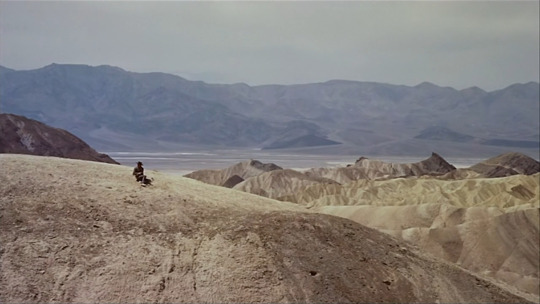
i don't actually know if i enjoyed this film or had a good time watching it. i don't know that i ever need to see it more than once.
it is artistically distinct, and i genuinely mean that as a compliment. it is a rare western-that-doesn’t-have-to-be-a-western, and such a weird artifact of a particular guy's career in a particular time.
surprisingly, this is a pretty okay western to watch if you happen to be a woman. katy jurado and pina pellicier are acting their GODDAMN hearts out. despite itself, the movie paints a very good portrait of a mother-daughter relationship and some goodass parenting. women make mistakes and don't die about it. nobody gets raped!!! the absolute lowest bar a western can possibly have. as a quick sidebar, it's not that i think movies should never address rape, it's that westerns always address it in a way that makes my stomach turn.
it is a slow-burning revenge that mostly takes place on a beach, but it also takes you in great uneven hurtling lurches toward its finale. it wants to have things to say about lies, revenge, and storytelling but cannot help but give itself a certain kind of ending. it can only push so far. it is fascinatingly earnest, horny, and earnest about being horny.
-
playing

grim fandango remastered (2015, originally 1998) by double fine. the EPIC tale of CRIME and CORRUPTION in the LAND OF THE DEAD!!! critically acclaimed, what we would now call Mexican Gothic i think, but billed itself as a Aztec-inspired noir.
technical details: i am not totally impressed by this remaster bc it still looks pretty fucking janky in parts (things clipping through other things, heavily pixelated stuff despite being on the highest quality settings, etc)
why i bounced off: i did not play video games growing up, and have not played many point-and-click games. despite this i do like walking simulators (the modern successor to point-and-click) and visual novels. i think bc i do not have the point-and-click background and am not playing this through nostalgia-tinted glasses for 1998, four years after i was born, the way the design team of this game expect the general population to solve problems and the way i personally solve problems are severely mismatched. i have spent about ten hours playing this game (in four acts) getting to about halfway through the third act, and i would say about half that time has been looking for/at guides or making up lost progress bc i didn't save. this is a tremendously frustrating way to spend free time.

what i did love: however, it does Look. i ADORE this tile and want it in my home. in a cutscene in this little automat there are not one not two not three but FOUR reflective surfaces. they're not real-time, of course, but i did say "what the FUCK" out loud. it's also hysterically fucking funny! many short sharp barks of laughter! i am greatly amused at how a game about skeletons invented permadeath! both the writing and the voice performances are so fucking top notch. i understand why this is a beloved classic and im glad a remastered edition exists in the world, but i do not anticipate finishing this game bc i don't get a lot of joy out of having to closely follow a guide to progress.
how i found this: it was free on GOG several years ago, i wanted to play something this weekend that was compatible with lying down on the couch and used a maximum of one finger for the controls.
-
making
i cannot show any of the extremely doxxable embroidery samples that will zhuzh up this cardigan for a work event in mid-june, but i can show how i tacked the buttonband down. this is somewhat indifferent stitch spacing but it stays down and is invisible at a distance from the right side, and that's what matters. gotta de-pill this also but that's a bit boring for a tuesdaypost


25 notes
·
View notes